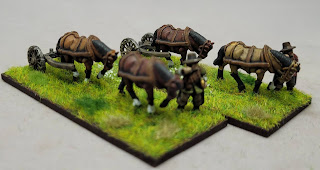Naseby Windmill
It's all that Streeter's fault: if you have read the other posts on this blog (well done, congratulations for still being here 😉) you'll know that Streeter's engraving of Naseby has held sway over my imagination for most of my life.
A major landmark on the engraving is the windmill, long since gone, the site it stood on is now where the memorial obelisk stands. So, as you can imagine I've unconsciously been looking out for a suitable 15mm representation. Well I think I've found one.
Can't remember how or why I found the site, but I do remember bookmarking it.
Ironclad Miniatures make a windmill for the Russian front which I think is fairly representative of the Naseby mill. Obviously I am only talking about the main body of the windmill, the base isn't quite right, a more accurate one shouldn't be too difficult to scratchbuild.
The windmill comes in four resin pieces, and a sprue of the sails, ladder etc. It is solid resin so is fairly weighty, so the new base would need some 'heft' to it to stop the whole thing toppling over.
After much thought I decided how I would recreate the wooden supports of the windmill: I'd already decided that the base would be Milliput, so I could connect the mill to the base on a single piece of brass rod, with the diagonal supports being cosmetic only (I really didn't fancy drilling at an angle).
The stone base was made with Milliput, using a pastry cutter (55mm diameter) to cut the basic shape out. I had intended to carve the stone blocks into the base but quickly realised that it would be very time consuming. I settled on a flattened, ovalised brush protector to press the block shapes into the Milliput. They do look a bit too regular in shape close up, but once painted and on the tabletop they should be less obvious.
I drilled into the mill 'body', and through my base to connect the two parts with a 1/8" brass rod. The cross braced supports were 1.5mm rod.
If you look at the windmill on the engraving, it looks as though there are timbers between the cross braced supports. So these were added using the 1.5mm rod. The top of the pedestal was covered with coarse basing grit, then undercoated with Liquitex raw umber.
Basing grit dry brushed like all my bases, stone work RailMatch weathered stone, wooden support Cd'A wood. Then a good coat of washes (nuln oil and dervlin mud). Windmill building Humbrol natural wood with a dervlin mud wash.
Whilst the wooden supports are much lower than those illustrated by Streeter it is the right height to use a Magister Militum ladder with, and it also feels right with figures next to it.
Update: postie has finally delivered the base I ordered, so I've been able to finish the windmill.
A major landmark on the engraving is the windmill, long since gone, the site it stood on is now where the memorial obelisk stands. So, as you can imagine I've unconsciously been looking out for a suitable 15mm representation. Well I think I've found one.
Can't remember how or why I found the site, but I do remember bookmarking it.
Ironclad Miniatures make a windmill for the Russian front which I think is fairly representative of the Naseby mill. Obviously I am only talking about the main body of the windmill, the base isn't quite right, a more accurate one shouldn't be too difficult to scratchbuild.
The windmill comes in four resin pieces, and a sprue of the sails, ladder etc. It is solid resin so is fairly weighty, so the new base would need some 'heft' to it to stop the whole thing toppling over.
After much thought I decided how I would recreate the wooden supports of the windmill: I'd already decided that the base would be Milliput, so I could connect the mill to the base on a single piece of brass rod, with the diagonal supports being cosmetic only (I really didn't fancy drilling at an angle).
The stone base was made with Milliput, using a pastry cutter (55mm diameter) to cut the basic shape out. I had intended to carve the stone blocks into the base but quickly realised that it would be very time consuming. I settled on a flattened, ovalised brush protector to press the block shapes into the Milliput. They do look a bit too regular in shape close up, but once painted and on the tabletop they should be less obvious.
I drilled into the mill 'body', and through my base to connect the two parts with a 1/8" brass rod. The cross braced supports were 1.5mm rod.
If you look at the windmill on the engraving, it looks as though there are timbers between the cross braced supports. So these were added using the 1.5mm rod. The top of the pedestal was covered with coarse basing grit, then undercoated with Liquitex raw umber.
Basing grit dry brushed like all my bases, stone work RailMatch weathered stone, wooden support Cd'A wood. Then a good coat of washes (nuln oil and dervlin mud). Windmill building Humbrol natural wood with a dervlin mud wash.
Whilst the wooden supports are much lower than those illustrated by Streeter it is the right height to use a Magister Militum ladder with, and it also feels right with figures next to it.
Update: postie has finally delivered the base I ordered, so I've been able to finish the windmill.
If you enjoyed reading this, or any of the other posts, please consider supporting the blog.
Thanks.
















Very nice!
ReplyDeleteThanks, wish the postie would hurry up and deliver its base so I can finish it.
ReplyDelete